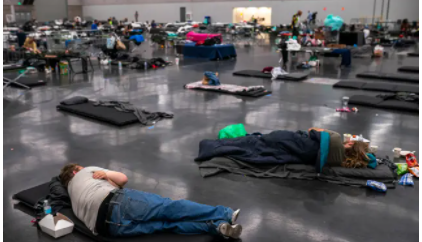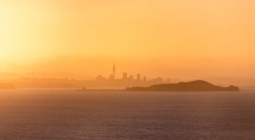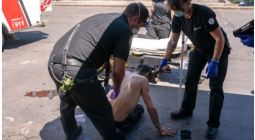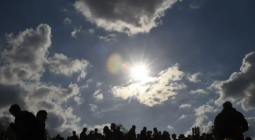Homeless people were already in a ‘humanitarian crisis’ during Covid. Then the Northwest heat wave hit

Coronavirus and wildfires were already making life very difficult for unhoused people in the Pacific Northwest, and this week’s record-breaking heat wave just made things worse, writes Josh Marcus
Even before this week’s record-breaking heatwave swept across the Pacific Northwest, there was a “humanitarian crisis” among the region’s unhoused people, according to Scott Kerman, executive director of Blanchet House, which offers free meals, housing, and other services in Portland, Oregon.
“Last summer and fall we had the horrific wildfires,” he told The Independent. “The smoke was unbearable. Then you get into the winter. Now we just went through an unprecedented heat wave. It was really a matter of life or death just to keep people hydrated.”
The organisation leapt into action, handing out chilled water bottles and reusable canteens, serving water-rich meals like salad and vegetables, and giving out hats and other clothing to help beat the heat.
But even with these efforts – and those of numerous good Samaritans in cities like Portland, which hit a record 116 degrees during the heat wave, and Seattle, which also had an unprecedented 108 degree reading – unhoused people are bearing the brunt of the crisis.

In Seattle, over just a three-day period, the fire department responded to 118 heat-related calls, with unhoused people making up a majority. These communities are feeling the pain most acutely because of a combination of current events and long-term factors, according to Mr Kerman.
Even those who do have houses in these normally rainy cities lack air conditioning, including 56 per cent of the population in Seattle and 21 per cent in Portland. So those without them, living in tents, motorhomes, or elsewhere, face even greater challenges staying cool and healthy. What’s more, the Covid crisis also spawned a related health crisis among unhoused people, exacerbating the sorts of underlying health challenges already disproportionately affecting this community.
“They have chronic physical and mental health or addiction challenges,” Mr Kerman said. “The situation has just worsened those conditions, maybe beyond repair.”
Even though cities like Portland and Seattle are home to booming high-tech economies, competitive housing markets, and trendy arts and culture scenes, they remain deeply unequal. Roughly 12,000 people are unhoused in Seattle, according to the most recent count, while roughly 4,000 are in Portland. Both figures are likely massive undercounts because they’re based on point-in-time figures collected by outreach teams. Even before the heatwave hit, Blanchet House was serving 60 per cent more meals in 2020 than the previous year.
Amid the heatwave, cities across the region opened air conditioned cooling centers and relaxed coronavirus requirements to allow more people to get into cooled-down spaces, but challenges still remained.
“It was miserable,” Neal Lampi, who lives in a motor home in Seattle, where 13 people have died from heat exposure, told Crosscut. Resources may be available, but severe health conditions and other factors can make it difficult for unhoused people to access them. While many other communities head towards full vaccination, unhoused people still lag behind because of the numerous personal and structural barriers in their way to getting treatment. Then there are more foundational reasons keeping people from the help they need.

(Getty Images)
“Folks are reticent to come into the cooling centers,” Jimmy Jones, who heads the Mid-Willamette Community Action Agency in the city of Salem, Oregon, told Oregon Public Broadcasting. “They don’t want to leave their encampments because they’re afraid that their property may be stolen or someone may tear up their tent. They tend to wait a little bit too long sometimes.”
Temperatures have begun to drop slightly as the heatwave shifts inland, and progress fighting coronavirus makes life easier, but that isn’t offering much respite. Temperatures in the region usually peak in July, so more heat could be on the way, and climate change makes future conditions even more dire.
“There will be more heatwaves, and there will very likely be a dangerous wildfire season,” Mr Kerman from Blanchet House said. “I think we’re excited that Oregon and places across the country are reopening and getting back to normal, but the message we keep emphasising is that the ‘normal’ people are going through is going to be very diffiult, very delayed. And maybe normal will never happen again.”
State and national leaders agreed that the heat wave was the latest manifestation of the climate crisis, which is making heat waves both more sever and more regular.
“I’m sure that people will – including public entities – start to build in cooling requirements and investments where that can be done,” Washington governor Jay Inslee said on Tuesday, but “there’s not enough chilling stations in the world to stop this problem if you don’t attack it at its source, which is climate change.” “Temperatures,” he added, “are just the tip of the melting iceberg.”
The climate crisis, according to experts, is being felt both apocalyptically and asymmetrically, with those in society who are already most vulnerable facing the greatest threats.They warn of the ongoing “climate change-homelessness nexus,” where rapid changes to natural systems both make more people unhoused, and cause those who already to experience greater difficulties.
July 2021
INDEPENDENT




